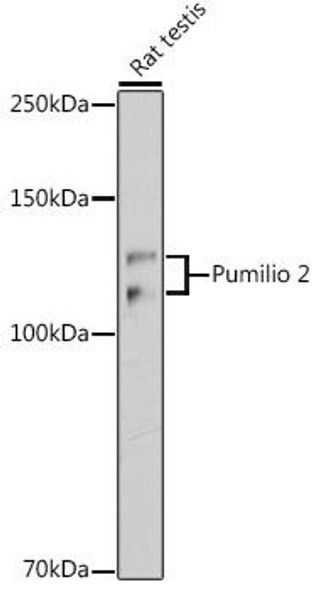Cell Biology Antibodies 8
Anti-TFF3 Antibody (CAB1978)
- SKU:
- CAB1978
- Product Type:
- Antibody
- Reactivity:
- Human
- Reactivity:
- Mouse
- Host Species:
- Rabbit
- Isotype:
- IgG
- Research Area:
- Cell Biology
Description
| Antibody Name: | Anti-TFF3 Antibody |
| Antibody SKU: | CAB1978 |
| Antibody Size: | 20uL, 50uL, 100uL |
| Application: | WB |
| Reactivity: | Human, Mouse |
| Host Species: | Rabbit |
| Immunogen: | Recombinant fusion protein containing a sequence corresponding to amino acids 22-94 of human TFF3 (NP_003217.3). |
| Application: | WB |
| Recommended Dilution: | WB 1:500 - 1:2000 |
| Reactivity: | Human, Mouse |
| Positive Samples: | Mouse liver, Mouse brain |
| Immunogen: | Recombinant fusion protein containing a sequence corresponding to amino acids 22-94 of human TFF3 (NP_003217.3). |
| Purification Method: | Affinity purification |
| Storage Buffer: | Store at -20'C. Avoid freeze / thaw cycles. Buffer: PBS with 0.02% sodium azide, 50% glycerol, pH7.3. |
| Isotype: | IgG |
| Sequence: | MLGL VLAL LSSS SAEE YVGL SANQ CAVP AKDR VDCG YPHV TPKE CNNR GCCF DSRI PGVP WCFK PLQE AECT F |
| Gene ID: | 7033 |
| Uniprot: | Q07654 |
| Cellular Location: | Cytoplasm, Secreted, extracellular matrix, extracellular space |
| Calculated MW: | 8kDa |
| Observed MW: | 18kDa |
| Synonyms: | TFF3, ITF, P1B, TFI |
| Background: | Members of the trefoil family are characterized by having at least one copy of the trefoil motif, a 40-amino acid domain that contains three conserved disulfides. They are stable secretory proteins expressed in gastrointestinal mucosa. Their functions are not defined, but they may protect the mucosa from insults, stabilize the mucus layer and affect healing of the epithelium. This gene is expressed in goblet cells of the intestines and colon. This gene and two other related trefoil family member genes are found in a cluster on chromosome 21. |
| UniProt Protein Function: | TFF3: Involved in the maintenance and repair of the intestinal mucosa. Promotes the mobility of epithelial cells in healing processes (motogen). |
| UniProt Protein Details: | Protein type:Secreted; Secreted, signal peptide Chromosomal Location of Human Ortholog: 21q22.3 Cellular Component: proteinaceous extracellular matrix; extracellular region; secretory granule Biological Process: response to peptide hormone stimulus; digestion; defense response |
| NCBI Summary: | Members of the trefoil family are characterized by having at least one copy of the trefoil motif, a 40-amino acid domain that contains three conserved disulfides. They are stable secretory proteins expressed in gastrointestinal mucosa. Their functions are not defined, but they may protect the mucosa from insults, stabilize the mucus layer and affect healing of the epithelium. This gene is expressed in goblet cells of the intestines and colon. This gene and two other related trefoil family member genes are found in a cluster on chromosome 21. [provided by RefSeq, Jul 2008] |
| UniProt Code: | Q07654 |
| NCBI GenInfo Identifier: | 585328 |
| NCBI Gene ID: | 7033 |
| NCBI Accession: | Q07654.1 |
| UniProt Secondary Accession: | Q07654,Q96NX0, Q9UDA5, E9PBB5, |
| UniProt Related Accession: | Q07654 |
| Molecular Weight: | 80 |
| NCBI Full Name: | Trefoil factor 3 |
| NCBI Synonym Full Names: | trefoil factor 3 (intestinal) |
| NCBI Official Symbol: | TFF3 |
| NCBI Official Synonym Symbols: | ITF; P1B; TFI |
| NCBI Protein Information: | trefoil factor 3; polypeptide P1.B |
| UniProt Protein Name: | Trefoil factor 3 |
| UniProt Synonym Protein Names: | Intestinal trefoil factor; hITF; Polypeptide P1.B; hP1.B |
| Protein Family: | Trefoil factor |
| UniProt Gene Name: | TFF3 |
| UniProt Entry Name: | TFF3_HUMAN |
View AllClose







